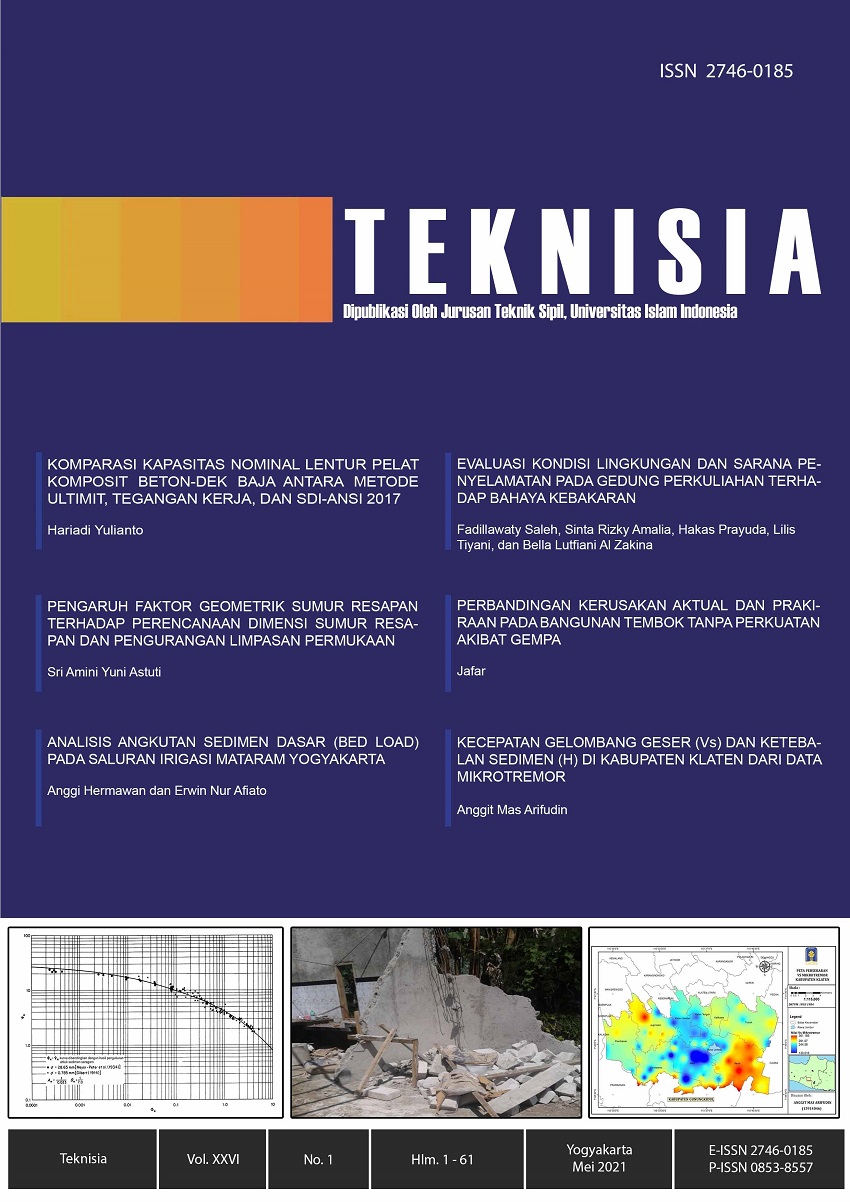Main Article Content
Abstract
Keywords
Article Details
Under the following term:
-
Attribution — You must give appropriate credit, provide a link to the license, and indicate if changes were made. You may do so in any reasonable manner, but not in any way that suggests the licensor endorses you or your use.
-
ShareAlike — If you remix, transform, or build upon the material, you must distribute your contributions under the same license as the original.
- No additional restrictions — You may not apply legal terms or technological measures that legally restrict others from doing anything the license permits.
References
- Bardet, & Tobita. (2001). “A computer program for nonlinear earthquake site response analysis of layered soil deposits”. California: Department of Civil Engineering, University Of Southern California.
- BMKG (2016). “Data Gempabumi dirasakan di DIY dan sekitarnya”. Yogyakarta.
- Daryono. (2011). “Indeks Kerentanan Seismik Berdasarkan Mikrotremor pada setiap satuan bentuk Lahan di Zona Graben Bantul Daerah Istimewa Yogkarta”. Yogyakarta: Disertasi, Universitas Gadjah Mada.
- Daryono, & T. R. (2007). “Data Mikrotremor dan Pemanfaatannya Untuk Pengkajian Bahaya Gempa Bumi”. Badan Meteorologu Klimatologi dan Geofisika.
- Gurler, Nakamura, Saita, & Sato. (t.thn.). “Local Site Effect of Mexico City Based on Microtremor Measurement”. System and Data Research Co., Ltd, Tokyo 186-0003, Japan.
- Irjan dan Bukhori, A. (2010). “Pemetaan Wilayah Rawan Bencana berdasarkan Data Mikroseismik Menggunakan TDS (Time Digital Seismograf) Type 303 Study Kasus : Kampus I UIN Maulana Malik Ibrahim Malang”. Jurnal Neutrino Vol.3 No.2.
- Ishihara, K. (1982). “Evaluation of Soil Properties for use in Earthquake response analysis”. Proceedings International Symo. On Num. Model in Geomechanics, (hal. 237-259).
- Ishihara, K. (1978). “Introduction to Dynamic Soil Mechanism. in Japanese”.
- Nakamura, Y. (1989). “A method for dynamic characteristic estimation of subsurface using microtremor on the ground surface”. Q.R of R.T.I 30-1 , 25-33.
- Nakamura, Y. (2007). “Development of vulnerability assesment for ground and structures using microtremor”. System and Data Research Co., Ltd.
- Nakamura, Y. (2008). “On The H/V Spectrum”. The 14th World Conference on Earthquake Engineering, October 12-17, 2008. Beijing, China.
- SESAME. (2004). “Guidelines for the Implementation of the H/V Spectral Ratio Technique on Ambient Vibratio Measurement, Processing and Interpretation”. European Commission - Reseacrh General Directorate.
- Widodo. (2012). “Seismologi Teknik dan Rekayasa Kegempaan”. Yogyakarta: Pustaka Pelajar.
References
Bardet, & Tobita. (2001). “A computer program for nonlinear earthquake site response analysis of layered soil deposits”. California: Department of Civil Engineering, University Of Southern California.
BMKG (2016). “Data Gempabumi dirasakan di DIY dan sekitarnya”. Yogyakarta.
Daryono. (2011). “Indeks Kerentanan Seismik Berdasarkan Mikrotremor pada setiap satuan bentuk Lahan di Zona Graben Bantul Daerah Istimewa Yogkarta”. Yogyakarta: Disertasi, Universitas Gadjah Mada.
Daryono, & T. R. (2007). “Data Mikrotremor dan Pemanfaatannya Untuk Pengkajian Bahaya Gempa Bumi”. Badan Meteorologu Klimatologi dan Geofisika.
Gurler, Nakamura, Saita, & Sato. (t.thn.). “Local Site Effect of Mexico City Based on Microtremor Measurement”. System and Data Research Co., Ltd, Tokyo 186-0003, Japan.
Irjan dan Bukhori, A. (2010). “Pemetaan Wilayah Rawan Bencana berdasarkan Data Mikroseismik Menggunakan TDS (Time Digital Seismograf) Type 303 Study Kasus : Kampus I UIN Maulana Malik Ibrahim Malang”. Jurnal Neutrino Vol.3 No.2.
Ishihara, K. (1982). “Evaluation of Soil Properties for use in Earthquake response analysis”. Proceedings International Symo. On Num. Model in Geomechanics, (hal. 237-259).
Ishihara, K. (1978). “Introduction to Dynamic Soil Mechanism. in Japanese”.
Nakamura, Y. (1989). “A method for dynamic characteristic estimation of subsurface using microtremor on the ground surface”. Q.R of R.T.I 30-1 , 25-33.
Nakamura, Y. (2007). “Development of vulnerability assesment for ground and structures using microtremor”. System and Data Research Co., Ltd.
Nakamura, Y. (2008). “On The H/V Spectrum”. The 14th World Conference on Earthquake Engineering, October 12-17, 2008. Beijing, China.
SESAME. (2004). “Guidelines for the Implementation of the H/V Spectral Ratio Technique on Ambient Vibratio Measurement, Processing and Interpretation”. European Commission - Reseacrh General Directorate.
Widodo. (2012). “Seismologi Teknik dan Rekayasa Kegempaan”. Yogyakarta: Pustaka Pelajar.
